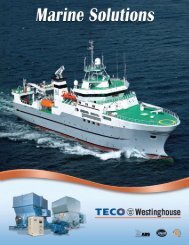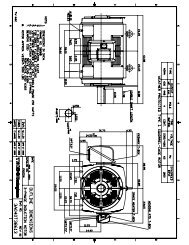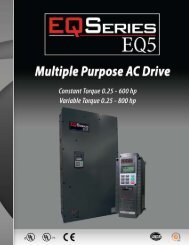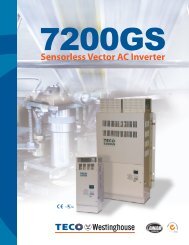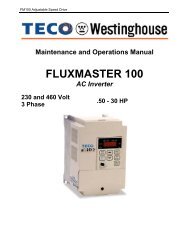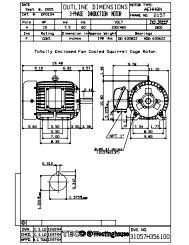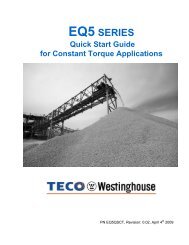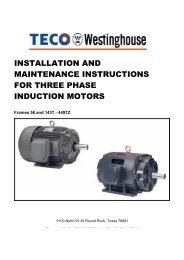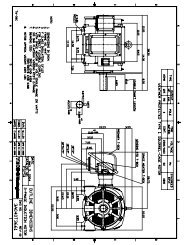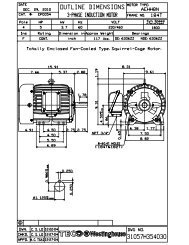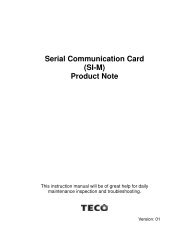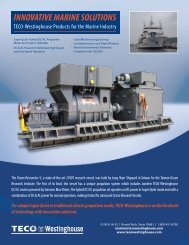EQ7 Series Instruction Manual - TECO-Westinghouse Motor Company
EQ7 Series Instruction Manual - TECO-Westinghouse Motor Company
EQ7 Series Instruction Manual - TECO-Westinghouse Motor Company
Create successful ePaper yourself
Turn your PDF publications into a flip-book with our unique Google optimized e-Paper software.
Item Specifications Remarks<br />
PID control<br />
• PID adjuster for process control and that for dancer control<br />
• Switchable between forward and reverse operations<br />
• Low liquid level stop function (pressurized operation possible before low liquid level stop)<br />
• PID command: Keypad, analog input (from terminals [12], C1, V2), RS-485 communications<br />
• PID feedback value: Analog input (from terminals [12], C1, V2)<br />
• Alarm output (absolute value alarm, deviation alarm)<br />
• PID output limiter<br />
• Integration reset/ho<br />
Auto search for idling motor speed<br />
• Estimates the speed of the motor running under no load and starts the motor without stopping it. (<strong>Motor</strong> electric constant needs<br />
tuning: Offline tuning) *1 to * 2 and *6<br />
Automatic deceleration<br />
• If the DC link bus voltage or calculated torque exceeds the automatic deceleration level during deceleration, the<br />
inverter automatically prolongs the deceleration time to avoid overvoltage trip.<br />
(It is possible to select forcible deceleration actuated wh<br />
• If the calculated torque exceeds automatic deceleration level during constant speed operation, the inverter avoids overvoltage<br />
trip by increasing the frequency.<br />
Deceleration characteristic<br />
(improving braking ability)<br />
Automatic energy saving operation<br />
Overload prevention control<br />
• The motor loss is increased during decel. to reduce the regenerative energy in the inverter to avoid overvoltage trip. *1<br />
• The output voltage is controlled to minimize the total sum of the motor loss and inverter loss at a constant speed.<br />
• If the ambient temperature or IGBT joint temperature increases due to overload, the inverter lowers the output<br />
frequency to avoid overload.<br />
Off-line tuning<br />
• Rotary type and non-rotary type are available for tuning the motor constant.<br />
Control<br />
On-line tuning<br />
Cooling fan ON/OFF control<br />
• Performs tuning while the motor is rotating in order to cover the motor speed fluctuation caused by the temperature rise of<br />
motor.<br />
• Detects inverter internal temperature of the inverter and stops the cooling fan when the temperature is low.<br />
• The fan control signal can be output to an external device.<br />
the<br />
Setting 2nd motor<br />
• Switchable among the two motors<br />
• Code data for four kinds of specific functions can be switched (even during operation).<br />
It is possible to set the base frequency, rated current, torque boost, and electronic thermal slip compensation as the data for 1st to<br />
2nd motors.<br />
Universal DI<br />
• The status of external digital signal connected with the universal digital input terminal is transferred to the host controller.<br />
Universal DO<br />
Universal AO<br />
Speed control • Notch filter for vibration control, *7<br />
• Digital command signal from the host controller is output to the universal digital output terminal.<br />
• The analog command signal from the host controller is output to the analog output terminal.<br />
Synchronous operation • Synchronous control drives two or more shafts of a conveyer while keeping their positions in synchronization. *7<br />
Preliminary excitation<br />
• Excitation is carried out to create the motor flux before starting the motor. *6 and*7<br />
Zero speed control • The motor speed is held to zero by forcibly zeroing the speed command. *7<br />
Servo lock • Stops the inverter and holds the motor in stop position. *7<br />
Torque control *6, *7<br />
• Analog torque command input<br />
• Speed limit function is provided to prevent the motor from becoming out of control.<br />
Rotation direction control<br />
• Preventing reverse rotation<br />
• Preventing forward rotation<br />
Preventing condensation in motor<br />
• When the inverter is stopped, current is automatically supplied to the motor to keep the motor warm and avoid condensation.<br />
Battery Operation<br />
• The battery operation enables the undervoltage inverter to run the elevator with a battery for moving the cage to the nearest floor.<br />
Run/stop<br />
Speed monitor<br />
(set frequency, output frequency, motor speed, load shaft speed, line speed, and speed indication with percent) Output current [A],<br />
output voltage [V], calculated torque, input power [HP], PID reference value, PID feedback value, PID output<br />
Inverter life warning<br />
• Life judgment of the main circuit capacitor, electrolytic capacitor on printed circuit board, and cooling fan<br />
• Life warning information can be output to an external device.<br />
• Ambient temperature: 40˚C, Load rate: inverter rated current 100% (LD type: 80%)<br />
Display<br />
Cumulative running hours<br />
• Displays the inverter cumulative running hours, integrated power, cumulative motor running hours, and the number of operation<br />
start times (of each motor).<br />
• Outputs the warning when the maintenance time or the number of start times has exceeded the preset<br />
Trip mode<br />
Light-alarm<br />
Running or trip mode<br />
• Displays the cause of trip.<br />
• Shows the light-alarm display [L-AL].<br />
• Trip history: Saves and displays the cause of the last four trips (with a code).<br />
• Also saves and displays the detailed data recorded on occurrence of the last four trips.<br />
11-9



